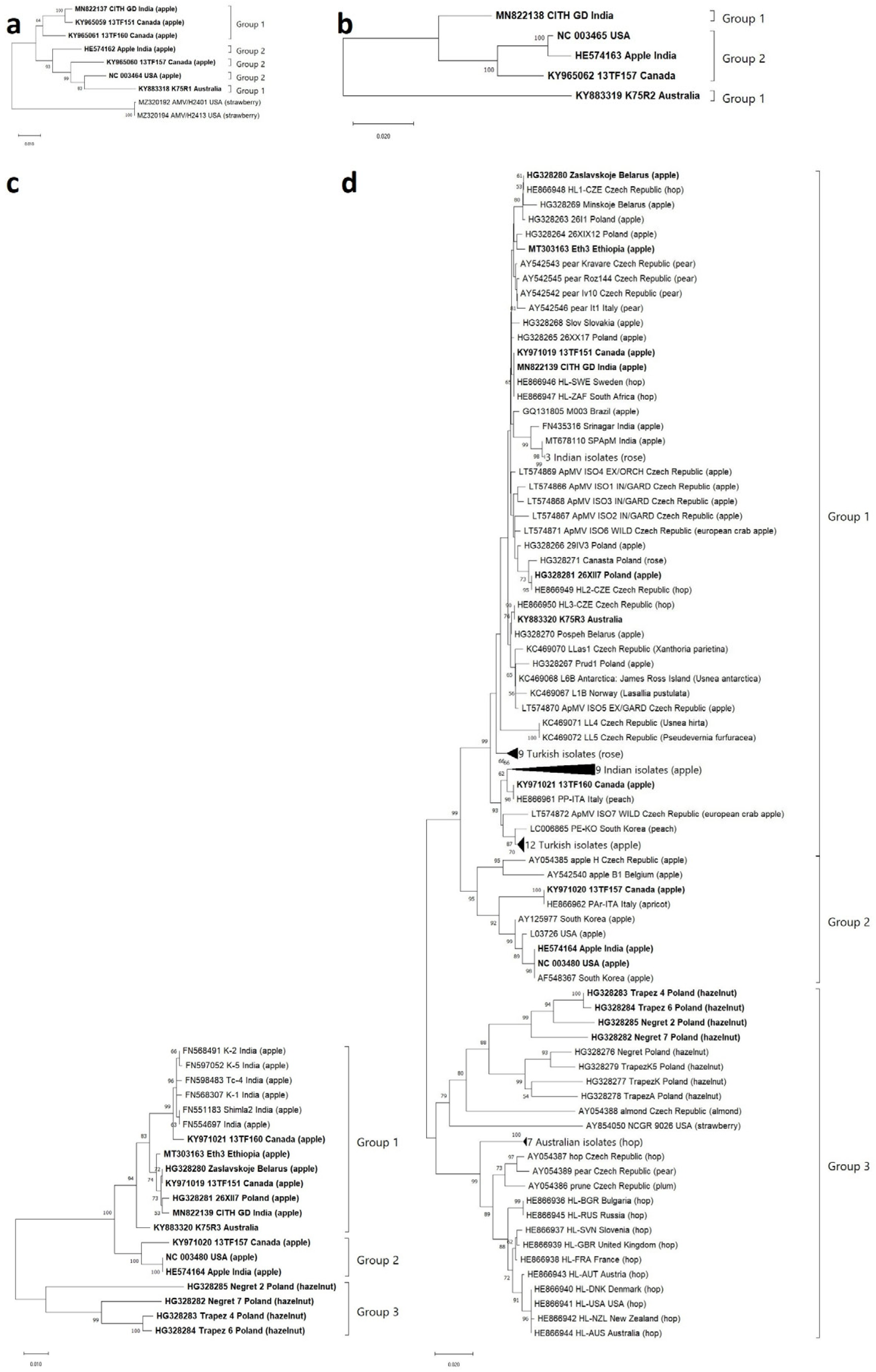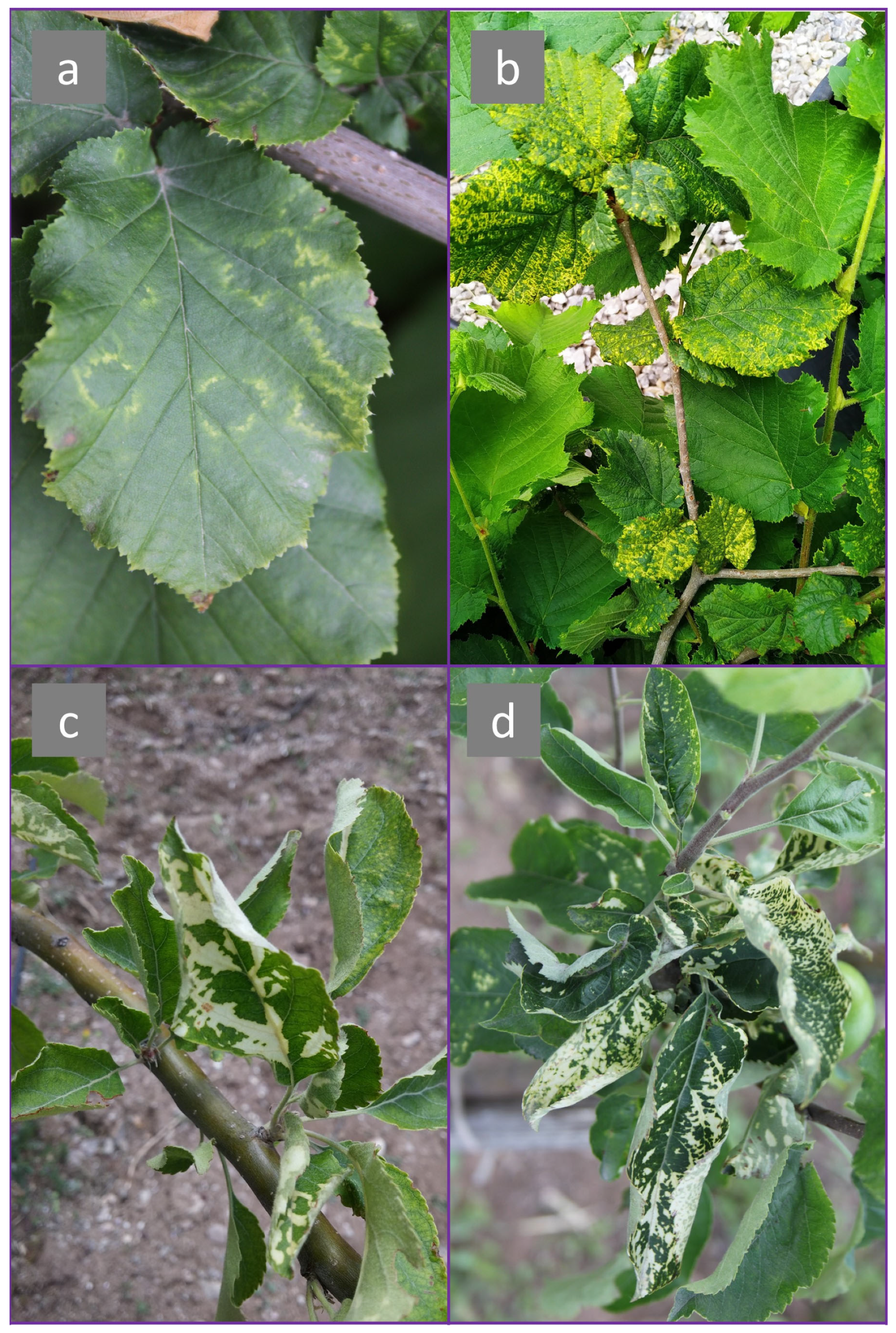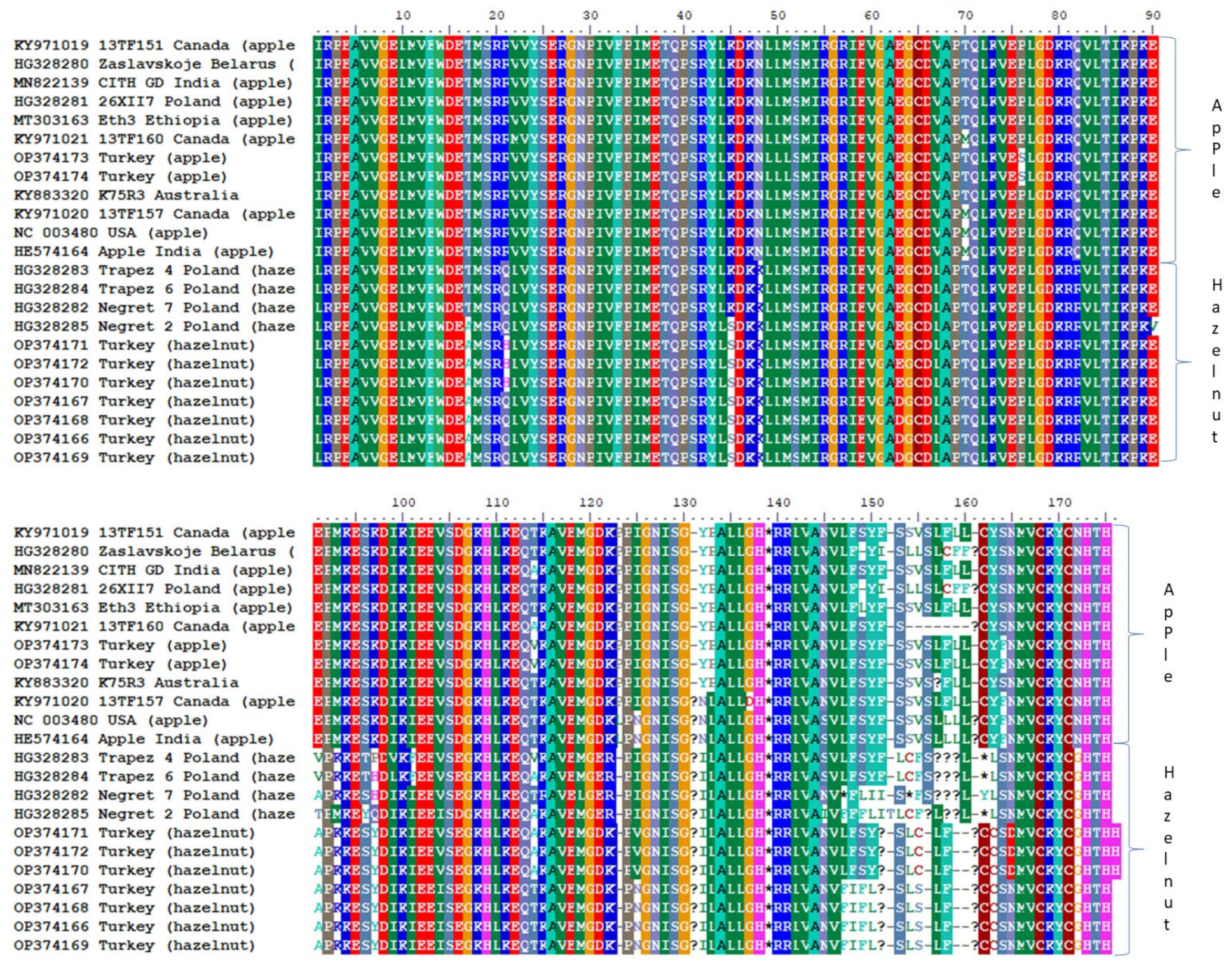Global Population Structure of Apple Mosaic Virus (ApMV, Genus Ilarvirus)
Abstract
1. Introduction
2. Materials and Methods
2.1. Alignment Datasets and Recombination Analysis
2.2. Phylogenetic and Comparative Nucleotide and Amino Acid Analyses
2.3. Genetic Diversity, Polymorphism, and Neutral Selection Analyses
2.4. Gene Flow and Genetic Differentiation among Populations
2.5. Acquisition of Partial Sequences of Turkish Isolates and Their Phylogeny
3. Results
3.1. Phylogenetic and Recombination Analyses
3.2. Comparative Nucleotide and Amino Acid Analyses
3.3. Genetic Diversity and Polymorphism Analyses
3.4. Neutral Selection Analysis
3.5. Gene Flow and Genetic Differentiation among Populations
3.6. Phylogeny of Novel Turkish Isolates
4. Discussion
5. Conclusions
Supplementary Materials
Author Contributions
Funding
Institutional Review Board Statement
Informed Consent Statement
Data Availability Statement
Acknowledgments
Conflicts of Interest
References
- Petrzik, K.; Lenz, O. Remarkable variability of apple mosaic virus capsid protein gene after nucleotide position 141. Arch. Virol. 2002, 147, 1275–1285. [Google Scholar] [CrossRef]
- Lakshmi, V.; Hallan, V.; Ram, R.; Ahmed, N.; Zaidi, A.A.; Varma, A. Diversity of Apple mosaic virus isolates in India based on coat protein and movement protein genes. Indian J. Virol. 2011, 22, 44–49. [Google Scholar] [CrossRef]
- Cho, I.S.; Cho, J.D.; Choi, S.K.; Choi, G.S. Occurrence of stone fruit viruses on peach trees (Prunus persica L. Batsch) in Korea. Res. Plant. Dis. 2012, 18, 391–395. [Google Scholar] [CrossRef]
- Petrzik, K.; Vondrák, J.; Barták, M.; Peksa, O.; Kubešová, O. Lichens—A new source or yet unknown host of herbaceous plant viruses? Eur. J. Plant Pathol. 2014, 138, 549–559. [Google Scholar] [CrossRef]
- Valasevich, N.; Cieślińska, M.; Kolbanova, E. Molecular characterization of Apple mosaic virus isolates from apple and rose. Eur. J. Plant Pathol. 2015, 141, 839–845. [Google Scholar] [CrossRef]
- Cieślińska, M.; Valasevich, N. Characterization of Apple mosaic virus isolates detected in hazelnut in Poland. J. Plant Dis. Prot. 2016, 123, 187–192. [Google Scholar] [CrossRef][Green Version]
- Grimová, L.; Winkowska, L.; Zíka, L.; Ryšánek, P. Distribution of viruses in old commercial and abandoned orchards and wild apple trees. J. Plant Pathol. 2016, 98, 549–554. [Google Scholar] [CrossRef]
- Postman, J.D.; Mahlenbacher, S.A. Apple mosaic virus in hazelnut germplasm. Acta Hortic. 1994, 351, 601–605. [Google Scholar] [CrossRef]
- Aramburu, J.; Rovira, M. Incidence and natural spread of Apple mosaic ilarvirus in hazel in north-east Spain. Plant Pathol. 2000, 49, 423–427. [Google Scholar] [CrossRef]
- Digiaro, M.; Savino, V.; Terlizzi, B.D. Ilarviruses in apricot and plum pollen. Acta Hortic. 1992, 309, 93–98. [Google Scholar] [CrossRef]
- Nabi, S.U.; Baranwal, V.K.; Rao, G.P.; Mansoor, S.; Vladulescu, C.; Raja, W.H.; Jan, B.L.; Alansi, S. High-throughput RNA sequencing of mosaic infected and non-infected apple (Malus x domestica Borkh.) cultivars: From detection to the reconstruction of whole genome of viruses and viroid. Plants 2022, 11, 675. [Google Scholar] [CrossRef] [PubMed]
- Shiel, P.J.; Alrefai, R.H.; Domier, L.L.; Korban, S.S.; Berger, P.H. The complete nucleotide sequence of apple mosaic virus RNA-3. Arch. Virol. 1995, 140, 1247–1256. [Google Scholar] [CrossRef]
- Shiel, P.J.; Berger, P.H. The complete nucleotide sequence of apple mosaic virus (ApMV) RNA 1 and RNA 2: ApMV is more closely related to alfalfa mosaic virus than to other ilarviruses. J. Gen. Virol. 2000, 81, 273–278. [Google Scholar] [CrossRef]
- Codoner, F.M.; Elena, S.F. The promiscuous evolutionary history of the family Bromoviridae. J. Gen. Virol. 2008, 89, 1739–1747. [Google Scholar] [CrossRef] [PubMed]
- Pallas, V.; Aparicio, F.; Herranz, M.C.; Amari, K.; Sanchez-Pina, M.A.; Myrta, A.; Sanchez-Navarro, J.A. Ilarviruses of Prunus spp.: A continued concern for fruit trees. Phytopathology 2012, 102, 1108–1120. [Google Scholar] [CrossRef]
- Lee, G.P.; Ryu, K.H.; Kim, H.R.; Kim, C.S.; Lee, D.W.; Kim, J.S.; Park, M.H.; Noh, Y.M.; Choi, S.H.; Han, D.H.; et al. Cloning and phylogenetic characterization of coat protein genes of two isolates of Apple mosaic virus from ‘Fuji’ apple. Plant Pathol. J. 2002, 18, 259–265. [Google Scholar] [CrossRef]
- Grimová, L.; Winkowska, L.; Ryšánek, P.; Svoboda, P.; Petrzik, K. Reflects the coat protein variability of apple mosaic virus host preference? Virus Genes. 2013, 47, 119–125. [Google Scholar] [CrossRef]
- Korkmaz, G.; Sipahioglu, H.M.; Usta, M. Survey of Apple mosaic virus in apple-growing provinces of East Anatolia (Malatya and Van) by RNA probe hybridization assay and RT-PCR. Turk. J. Agric. For. 2013, 37, 711–718. [Google Scholar] [CrossRef]
- Ertunc, F.; Topkaya, S.; Sezer, A. Distribution and molecular detection of apple mosaic virus in apple and hazelnut in Turkey. Afr. J. Biotechnol. 2014, 13, 3144–3149. [Google Scholar] [CrossRef]
- Topkaya, Ş.; Çelik, A.; Santosa, A.I.; Jones, R.A.C. Molecular analysis of the global population of potato virus S redefines its phylogeny, and has crop biosecurity implications. Viruses 2023, 15, 1104. [Google Scholar] [CrossRef]
- Çelik, A.; Coşkan, S.; Morca, A.F.; Santosa, A.I.; Koolivand, D. Insight into population structure and evolutionary analysis of the emerging tomato brown rugose fruit virus. Plants 2022, 11, 3279. [Google Scholar] [CrossRef]
- Turkish Statistical Institute (TurkStat). Crop Production Statistics. 2021. Available online: https://data.tuik.gov.tr/ (accessed on 2 August 2022).
- Aramburu, J.M.; Rovira, M. Effects of apple mosaic virus (ApMV) on the growth and yield of ‘Negret’ hazelnut. Acta Hortic. 1995, 386, 565–568. [Google Scholar] [CrossRef]
- Akbaş, B.; Değirmenci, K. Incidence and natural spread of Apple mosaic virus on hazelnut in the West Black Sea coast of Turkey and its effect on yield. J. Plant Pathol. 2009, 91, 767–771. [Google Scholar]
- Kumar, S.; Stecher, G.; Li, M.; Knyaz, C.; Tamura, K. MEGA X: Molecular Evolutionary Genetics Analysis across computing platforms. Mol. Biol. Evol. 2018, 35, 1547–1549. [Google Scholar] [CrossRef] [PubMed]
- Martin, D.P.; Murrell, B.; Golden, M.; Khoosal, A.; Muhire, B. RDP4: Detection and analysis of recombination patterns in virus genomes. Virus Evol. 2015, 1, 1–5. [Google Scholar] [CrossRef]
- Kimura, M. A simple method for estimating evolutionary rate of base substitutions through comparative studies of nucleotide sequences. J. Mol. Evol. 1980, 16, 111–120. [Google Scholar] [CrossRef]
- Muhire, B.M.; Varsani, A.; Martin, D.P. SDT: A virus classification tool based on pairwise sequence alignment and identity calculation. PLoS ONE 2014, 9, e108277. [Google Scholar] [CrossRef]
- Rozas, J.; Ferrer-Mata, A.; Sánchez-DelBarrio, J.C.; Guirao-Rico, S.; Librado, P.; Ramos-Onsins, S.E.; Sanchez-Gracia, A. DnaSP 6: DNA sequence polymorphism analysis of large data sets. Mol. Biol. Evol. 2017, 34, 3299–3302. [Google Scholar] [CrossRef]
- Tajima, F. Statistical method for testing the neutral mutation hypothesis by DNA polymorphism. Genetics 1989, 123, 585–595. [Google Scholar] [CrossRef]
- Fu, Y.X.; Li, W.H. Statistical tests of neutrality of mutations. Genetics 1993, 133, 693–709. [Google Scholar] [CrossRef]
- Hudson, R.R.; Boos, D.D.; Kaplan, N.L. A statistical test for detecting geographic subdivision. Mol. Biol. Evol. 1992, 9, 138–151. [Google Scholar] [CrossRef]
- Hudson, R.R. A new statistic for detecting genetic differentiation. Genetics 2000, 155, 2011–2014. [Google Scholar] [CrossRef] [PubMed]
- Tsompana, M.; Abad, J.; Purugganan, M.; Moyer, J. The molecular population genetics of the Tomato spotted wilt virus (TSWV) genome. Mol. Ecol. 2005, 14, 53–66. [Google Scholar] [CrossRef] [PubMed]
- Hudson, R.R.; Slatkin, M.; Maddison, W.P. Estimation of levels of gene flow from DNA sequence data. Genetics 1992, 132, 583–589. [Google Scholar] [CrossRef] [PubMed]
- Coşkan, S.; Morca, A.F.; Akbaş, B.; Çelik, A.; Santosa, A.I. Comprehensive surveillance and population study on plum pox virus in Ankara Province of Turkey. J. Plant Dis. Prot. 2022, 129, 981–991. [Google Scholar] [CrossRef]
- Thompson, J.D.; Higgins, D.G.; Gibson, T.J. CLUSTAL W: Improving the sensitivity of progressive multiple sequence alignment through sequence weighting, position-specific gap penalties and weight matrix choice. Nucleic Acids Res. 1994, 22, 4673–4680. [Google Scholar] [CrossRef]
- National Center for Biotechnology Information. Primer-BLAST. 2023. Available online: https://www.ncbi.nlm.nih.gov/tools/primer-blast/index.cgi?GROUP_TARGET=on (accessed on 7 February 2023).
- Hall, T.A. BioEdit: A user-friendly biological sequence alignment editor and analysis program for Windows 95/98/NT. Nucl. Acids Symp. Ser. 1999, 41, 95–98. [Google Scholar]
- Çelik, A.; Santosa, A.I.; Gibbs, A.J.; Ertunç, F. Prunus necrotic ringspot virus in Turkey: An immigrant population. Arch. Virol. 2022, 167, 553–562. [Google Scholar] [CrossRef]





| No. | Recombinant | Parents: Major/Minor | Breakpoints 1 (Start/End) | RDP Implemented Method 2 (p Value) |
|---|---|---|---|---|
| P1 | ||||
| 1. | KY883318 (Australia) | NC_003464 (USA)/unknown | 2365/2790 | R (6.564 × 10−21) G (8.039 × 10−20) B (2.271 × 10−15) M (1.136 × 10−15) C (1.831 × 10−13) S (3.149 × 10−10) 3S (5.593 × 10−28) |
| 2. | KY883318 (Australia) | NC_003464 (USA)/KY965059 (Canada) | 360/3062 | R (9.084 × 10−12) G (1.468 × 10−7) B (8.045 × 10−12) M (3.028 × 10−8) C (5.966 × 10−7) S (1.456 × 10−4) 3S (2.376 × 10−6) |
| 3. | HE574162 (India) | KY965061 (Canada)/NC_003464 (USA) | 1288/2063 | R (6.740 × 10−16) G (3.307 × 10−14) B (3.122 × 10−16) M (3.925 × 10−11) C (1.939 × 10−11) S (2.879 × 10−14) 3S (9.453 × 10−16) |
| 4. | HE574162 (India) | KY965061 (Canada)/unknown | 2558/2879 | R (2.457 × 10−3) G (1.522 × 10−3) B (1.570 × 10−4) M (6.996 × 10−4) C (6.122 × 10−4) S (4.158 × 10−4) 3S (5.398 × 10−4) |
| P2 | ||||
| 1. | HE574163 (India) | KY965062 (Canada)/unknown | 493/1125 | R (2.001 × 10−8) G (4.360 × 10−4) B (4.893 × 10−5) M (1.883 × 10−9) C (2.128 × 10−3) S (3.546 × 10−6) 3S (4.883 × 10−6) |
| 2. | MN822138 (India) | KY883319 (Australia)/KY965062 (Canada) | 1132/2458 | R (3.834 × 10−11) G (3.646 × 10−10) B (3.876 × 10−9) M (1.759 × 10−12) C (4.075 × 10−6) S (1.325 × 10−39) 3S (1.322 × 10−26) |
| Genomic Region | Identity (%) | |
|---|---|---|
| nt | aa | |
| P1 | 91–99 | 78–99 |
| P2 | 87–96 | 89–96 |
| MP | 88–100 | 69–100 |
| group 1 × group 2 | 95–97 | 83–92 |
| group 1 × group 3 | 88–90 | 69–75 |
| group 2 × group 3 | 88–90 | 70–77 |
| CP | 87–100 | 69–100 |
| group 1 × group 2 | 93–94 | 77–88 |
| group 1 × group 3 | 87–91 | 69–78 |
| group 2 × group 3 | 87–91 | 69–78 |
| Phylogroups | N | h | Hd | S | η | k | π | dS | dN | ω |
|---|---|---|---|---|---|---|---|---|---|---|
| P1 | 7 | 7 | 1.000 | 389 | 407 | 177.143 | 0.056 | 0.092 | 0.047 | 0.511 |
| P2 | 3 | 3 | 1.000 | 381 | 389 | 256.667 | 0.112 | 0.275 | 0.047 | 0.171 |
| MP | 20 | 17 | 0.984 | 174 | 194 | 46.663 | 0.055 | 0.059 | 0.053 | 0.898 |
| Group 1 | 13 | 11 | 0.974 | 38 | 38 | 11.590 | 0.013 | 0.018 | 0.012 | 0.667 |
| Group 2 | 3 | 2 | 0.667 | 17 | 17 | 11.333 | 0.013 | 0.021 | 0.011 | 0.524 |
| Group 3 (=Hazenut) | 4 | 4 | 1.000 | 102 | 105 | 55.333 | 0.064 | 0.074 | 0.062 | 0.838 |
| CP | 114 | 87 | 0.994 | 257 | 321 | 37.870 | 0.063 | 0.073 | 0.059 | 0.808 |
| Group 1 | 75 | 54 | 0.990 | 136 | 149 | 17.081 | 0.027 | 0.031 | 0.026 | 0.839 |
| Group 2 | 9 | 6 | 0.889 | 63 | 65 | 23.583 | 0.035 | 0.038 | 0.032 | 0.842 |
| Group 3 | 30 | 27 | 0.991 | 198 | 235 | 49.085 | 0.076 | 0.094 | 0.069 | 0.734 |
| Hazelnut | 10 | 10 | 1.000 | 161 | 183 | 58.822 | 0.089 | 0.101 | 0.098 | 0.971 |
| Phylogroups | Fu and Li’s D * | Fu and Li’s F * | Tajima’s D |
|---|---|---|---|
| P1 | 0.78257 ns | 0.77054 ns | 0.39048 ns |
| P2 | nd | nd | nd |
| MP | −0.23355 ns | −0.23355 ns | −0.60877 ns |
| Group 1 | −0.94708 ns | −0.86588 ns | −0.23742 ns |
| Group 2 | nd | nd | nd |
| Group 3 (=Hazelnut) | −0.26300 ns | −0.29969 ns | −0.35436 ns |
| CP | −2.54107 * | −2.34983 * | −1.24742 ns |
| Group 1 | −3.45373 ** | −3.1910 ** | −1.50761 ns |
| Group 2 | 0.29956 ns | 0.23542 ns | −0.07131 ns |
| Group 3 | −0.98120 ns | −1.03740 ns | −0.66893 ns |
| Hazelnut | −0.44376 ns | −0.50406 ns | −0.45212 ns |
| Comparison | αKS * | αKST * | p Value | αZ * | p Value | Snn | p Value | βFST |
|---|---|---|---|---|---|---|---|---|
| MP | ||||||||
| Group 1 (n = 13)/Group 2 (n = 3) | 2.2753 | 0.1651 | 0.0020 ** | 3.4211 | 0.0010 ** | 1.0000 | 0.0020 ** | 0.6874 |
| Group 1 (n = 13)/Group 3 (n = 4) | 2.5339 | 0.2197 | 0.0000 *** | 3.5449 | 0.0000 *** | 1.0000 | 0.0000 *** | 0.6591 |
| Group 2 (n = 3)/Group 3 (n = 4) | 3.1513 | 0.2026 | 0.0070 ** | 1.4256 | 0.0330 * | 1.0000 | 0.0330 * | 0.6493 |
| CP | ||||||||
| Group 1 (n = 75)/Group 2 (n = 9) | 2.7341 | 0.0677 | 0.0000 *** | 6.9405 | 0.0000 *** | 1.0000 | 0.0000 *** | 0.5428 |
| Group 1 (n = 75)/Group 3 (n = 30) | 2.9091 | 0.1289 | 0.0000 *** | 7.2177 | 0.0000 *** | 0.9905 | 0.0000 *** | 0.5093 |
| Group 2 (n = 9)/Group 3 (n = 30) | 2.7341 | 0.0677 | 0.0000 *** | 6.9405 | 0.0000 *** | 1.0000 | 0.0000 *** | 0.5428 |
Disclaimer/Publisher’s Note: The statements, opinions and data contained in all publications are solely those of the individual author(s) and contributor(s) and not of MDPI and/or the editor(s). MDPI and/or the editor(s) disclaim responsibility for any injury to people or property resulting from any ideas, methods, instructions or products referred to in the content. |
© 2023 by the authors. Licensee MDPI, Basel, Switzerland. This article is an open access article distributed under the terms and conditions of the Creative Commons Attribution (CC BY) license (https://creativecommons.org/licenses/by/4.0/).
Share and Cite
Çelik, A.; Morca, A.F.; Coşkan, S.; Santosa, A.I. Global Population Structure of Apple Mosaic Virus (ApMV, Genus Ilarvirus). Viruses 2023, 15, 1221. https://doi.org/10.3390/v15061221
Çelik A, Morca AF, Coşkan S, Santosa AI. Global Population Structure of Apple Mosaic Virus (ApMV, Genus Ilarvirus). Viruses. 2023; 15(6):1221. https://doi.org/10.3390/v15061221
Chicago/Turabian StyleÇelik, Ali, Ali Ferhan Morca, Sevgi Coşkan, and Adyatma Irawan Santosa. 2023. "Global Population Structure of Apple Mosaic Virus (ApMV, Genus Ilarvirus)" Viruses 15, no. 6: 1221. https://doi.org/10.3390/v15061221
APA StyleÇelik, A., Morca, A. F., Coşkan, S., & Santosa, A. I. (2023). Global Population Structure of Apple Mosaic Virus (ApMV, Genus Ilarvirus). Viruses, 15(6), 1221. https://doi.org/10.3390/v15061221









